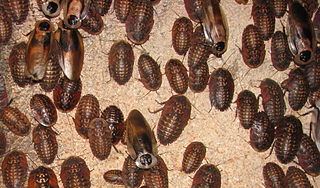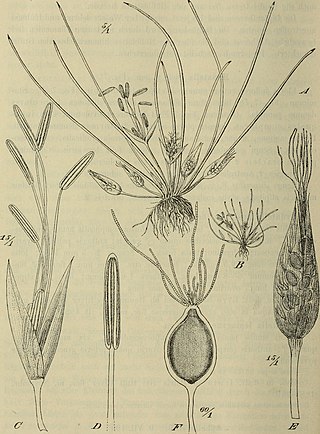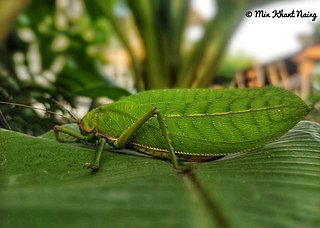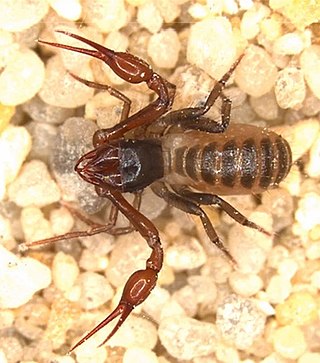
Pseudoscorpions, also known as false scorpions or book scorpions, are small, scorpion-like arachnids belonging to the order Pseudoscorpiones, also known as Pseudoscorpionida or Chelonethida.

Giant cockroaches, or blaberids, are the second-largest cockroach family by number of species.

Beyer, Peacock and Company was an English railway locomotive manufacturer with a factory in Openshaw, Manchester. Founded by Charles Beyer, Richard Peacock and Henry Robertson, it traded from 1854 until 1966. The company exported locomotives, and machine tools to service them, throughout the world.

Ectobiidae is a family of the order Blattodea (cockroaches). This family contains many of the smaller common household pest cockroaches, among others. They are sometimes called wood cockroaches. A few notable species include:

Hydatellaceae are a family of small, aquatic flowering plants. The family consists of tiny, relatively simple plants occurring in Australasia and India. It was formerly considered to be related to the grasses and sedges, but has been reassigned to the order Nymphaeales as a result of DNA and morphological analyses showing that it represents one of the earliest groups to split off in flowering-plant phylogeny, rather than having a close relationship to monocots, which it bears a superficial resemblance to due to convergent evolution. The family includes only the genus Trithuria, which has at least 13 species, although species diversity in the family has probably been substantially underestimated.

Trithuria is a genus of small ephemeral aquatic herb that represent the only members of the family Hydatellaceae found in India, Australia, and New Zealand. All of the 13 formally characterized species of Trithuria are found in Australia, with the exception of T. inconspicua and T. konkanensis, which are found in New Zealand and India, respectively. Until DNA sequence data and a reinterpretation of morphology proved otherwise, these plants were believed to be monocots related to the grasses (Poaceae). They are unique in being the only plants besides two members of Triuridaceae in which the stamens are in the center of the flower while the pistils surround them; in Hydatellaceae the resulting 'flowers' may instead represent condensed inflorescences or non-flowers.

Swietenia macrophylla, commonly known as mahogany, Honduran mahogany, Honduras mahogany, or big-leaf mahogany is a species of plant in the Meliaceae family. It is one of three species that yields genuine mahogany timber (Swietenia), the others being Swietenia mahagoni and Swietenia humilis. It is native to South America, Mexico and Central America, but naturalized in the Philippines, Singapore, Malaysia and Hawaii, and cultivated in plantations and wind-breaks elsewhere.

Chthoniidae is a family of pseudoscorpions within the superfamily Chthonioidea. The family contains more than 600 species in about 30 genera. Fossil species are known from Baltic, Dominican, and Burmese amber. Chthoniidae now includes the former families Tridenchthoniidae, and Lechytiidae which has been demoted to subfamilies.

The subfamily Pseudophyllinae contains numerous species in the family Tettigoniidae, the katydids or bush crickets. Sometimes called "true katydids", together with the crickets of suborder Ensifera, they form part of the insect order Orthoptera which also contains grasshoppers.
Quintaria is a genus of fungi in the family Lophiostomataceae.

Ornduffia is a genus of flowering plants in the family Menyanthaceae, native to Australia. Aquatic or wetland herbs, they were split off from Villarsia in 2009.
Ornduffia submersa is a species of plant in the Menyanthaceae family of wetland plants that is endemic to Western Australia.
Tyrannochthonius laevis is a species of pseudoscorpion in the Chthoniidae family. It is endemic to Australia. It was described in 1966 by Austrian arachnologist Max Beier.
Sathrochthonius crassidens is a species of pseudoscorpion in the Chthoniidae family. It is endemic to Australia. It was described in 1966 by Austrian arachnologist Max Beier.
Pseudotyrannochthonius bornemisszai is a species of pseudoscorpion in the Pseudotyrannochthoniidae family. It is endemic to Australia. It was described in 1966 by Austrian arachnologist Max Beier.

Pseudotyrannochthonius giganteus is a species of pseudoscorpion in the Pseudotyrannochthoniidae family. It is endemic to Australia. It was described in 1971 by Austrian arachnologist Max Beier.
Synsphyronus elegans is a species of pseudoscorpion in the Garypidae family. It is endemic to Australia. It was described in 1954 by Austrian arachnologist Max Beier.
Synsphyronus dewae is a species of pseudoscorpion in the Garypidae family. It is endemic to Australia. It was described in 1969 by Austrian arachnologist Max Beier.
Synsphyronus nullarborensis is a species of pseudoscorpion in the Garypidae family. It is endemic to Australia. It was described in 1969 by Austrian arachnologist Max Beier.
Synsphyronus gigas is a species of pseudoscorpion in the Garypidae family. It is endemic to Australia. It was described in 1971 by Austrian arachnologist Max Beier.










